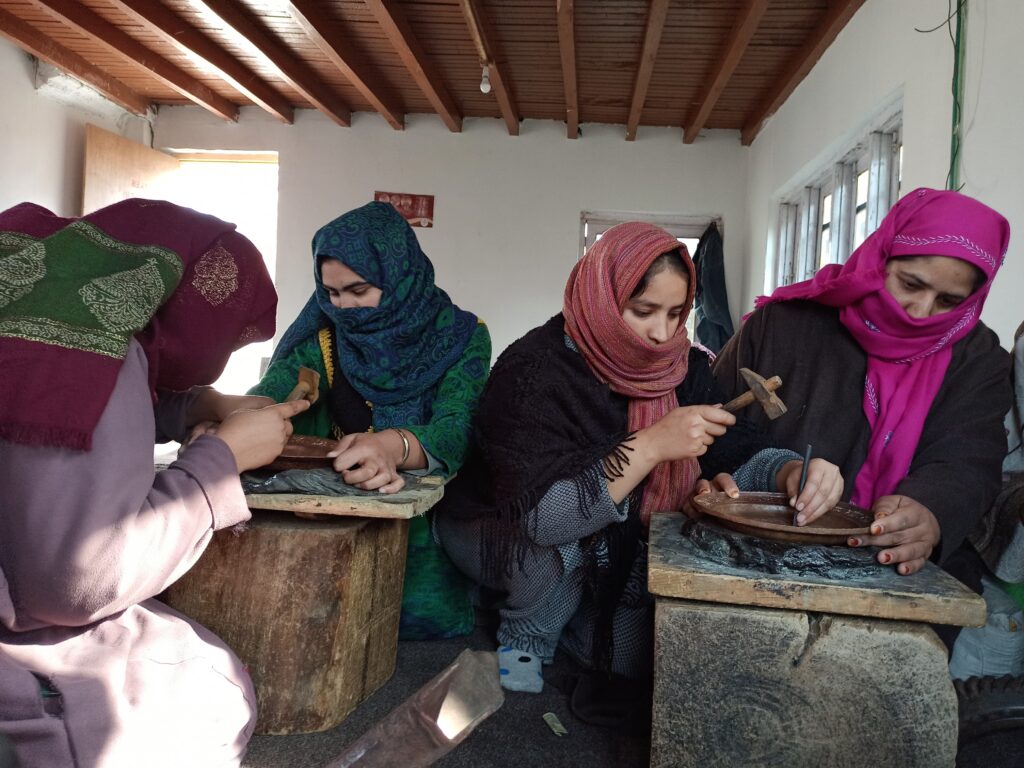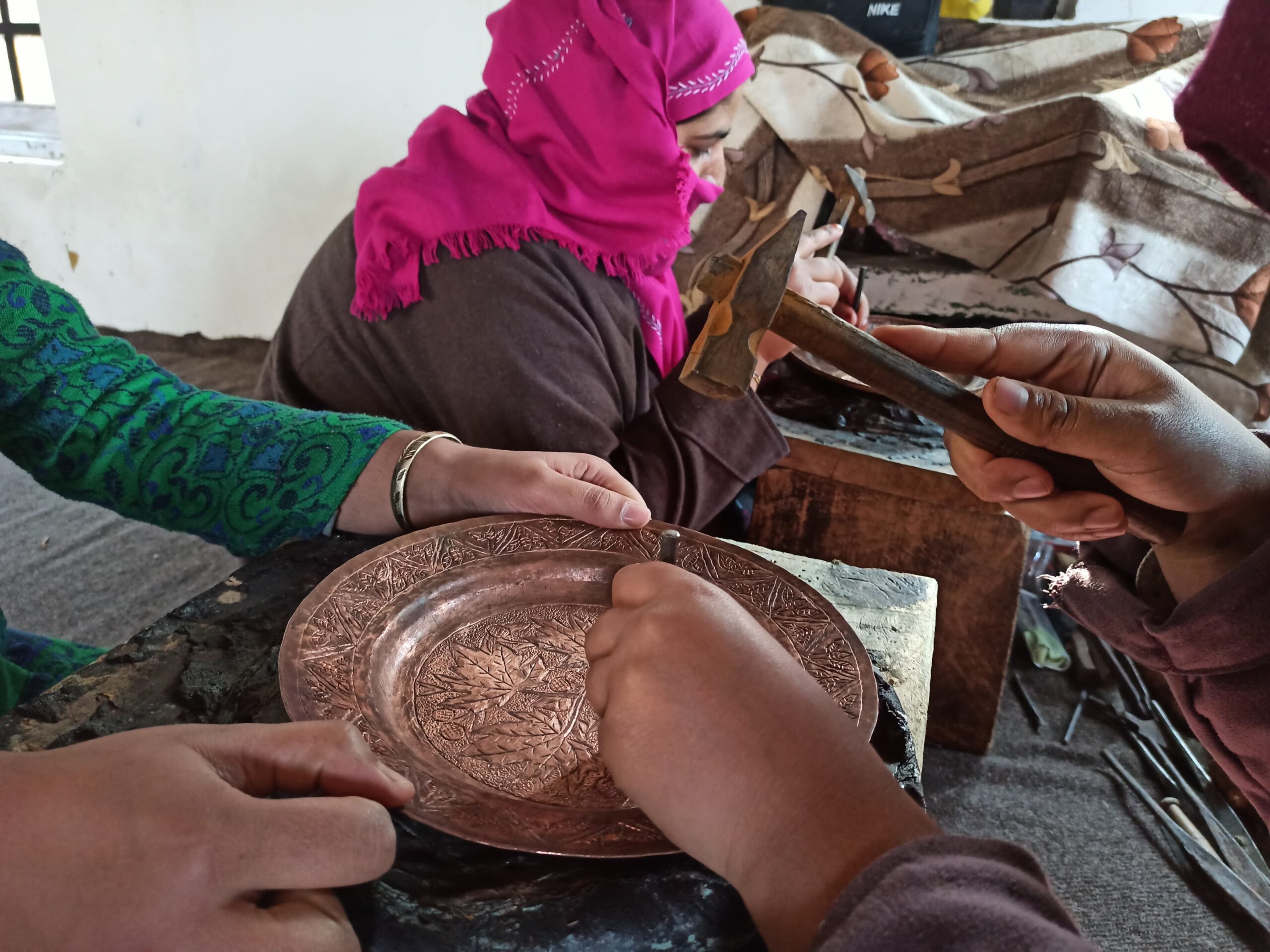The hidden talent of Balpora’s women lies in their intricate craftsmanship, shaping copper into works of art. The artistry, resilience, and dreams are the driving forces behind the flourishing community of coppersmiths in the village.
By Tauheed Ahmad
In the embrace of tranquillity along the meandering banks of Nallah Doodh Ganga lies the serene village of Balpora, Wathoora, its essence captured in the lull of nature’s symphony. Here, amidst the whispered secrets of rustling leaves and the soft babble of the flowing stream, a tale of determination and aspirations quietly unfurls. A humble enclave tucked away in the heart of the village, where the air is laced with the scent of copper and the echoes of resilience; a place where unmarried and married young girls converge regularly, drawn not just by routine training but by whispered dreams shared in hushed circles. Amidst this haven, a mosaic of aspirations emerges—some high school pass outs, some graduates—all united by a fervent desire to shape their destinies through the ancient craft of coppersmith.

In this unassuming room, a group of twenty young women, their eyes bright with determination and their hearts set on an unconventional path, were deeply engrossed in a craft that was breaking societal barriers. With unwavering focus, they were meticulously engraving intricate designs onto copper utensils, a skill they were honing to fulfill their dream of becoming coppersmiths.
The village, located about 5 kilometers from Chadoora town of Budgam district, where these young women–navigating the challenges of learning the art of copper engraving. Despite initial difficulties, these spirited trainees persevered, gradually mastering the use of various tools needed to shape copper into intricate designs.
Under the careful guidance of their instructor, much like a mentor teaching eager minds, they enthusiastically focused on engraving delicate designs. It was akin to a nurturing teacher, fostering creativity within her students’ hearts.
Challenges dotted their path as they encountered sporadic ridicule from society and family for selecting a profession that challenged traditional gender norms. Nazima, among the trainees, revealed the impact of societal pressure on some peers, causing them to abandon their aspirations post-engagement due to the stigma surrounding women entering male-dominated fields.
Nazima further emphasized her unwavering determination, disregarding the opinions of others, as she persisted in attending the classes despite societal judgments.
Acknowledged the initial societal stigma attached to the male-dominated field of coppersmith. Tahira, another trainee, stated, “Upon joining the center, a newfound interest emerged, solidifying my determination to pursue this intriguing profession.”
‘’Sometimes, when I’m molding or chiseling the motifs onto the copper plates, it feels like I’m not just crafting designs; I’m shaping my own destiny”, Tahira added.
However, these determined young women defied societal constraints, driven by their unwavering ambition to enter the coppersmith profession. The inception of a training center in May 2022, backed by the government’s Handicrafts and Handloom Department, emerged as a ray of hope, providing avenues for self-sufficiency to numerous young women in rural areas where viable job opportunities for females were limited.
Mukhtar Ahmad, the Junior Instructor at the Centre, delineated the diverse spectrum of designs the trainees specialized in, ranging from Chinar, Badam, Rezposh to Shaltarashi. He elaborated on the department’s pivotal role in fostering self-sufficiency, offering artisan cards and loans at a subsidized interest rate of 3 percent, enabling the establishment of independent business units.
“The provision of a monthly stipend of 1000 rupees for trainees in the elementary course and the department is support in facilitating exhibitions and online marketing for their custom-made items”, Mukhtar Ahmad, the Junior Instructor at the Centre said.
“Engraving on copper plates, the core focus of the training has emerged as both manageable and profitable. It has the potential to yield earnings up to 1000 rupees per day, contingent upon one’s expertise and the amount of work hours invested,” emphasized Mukhtar Ahmad, the Junior Instructor at the Centre.
He further said that the paradigm shift from the restricted engraving activities in Srinagar’s downtown to the broader reach in the valley’s remote areas, empowering young women to embrace their fortunes.
Amidst the challenges, these aspiring coppersmiths discovered solace and purpose within their craft. For them, the act of engraving copper transcended mere work; it symbolized a departure from the traditional female-centric occupations. Their labor was distinctive, arduous, and physically demanding, setting it apart from the customary roles typically confined to household spaces, such as tailoring or embroidery.
With relentless dedication, they hone their skills, specializing in intricate designs like Kandkari, which held substantial market value. Through their expertise, these women found empowerment and a sense of dignity in their work. The government’s provision of a monthly stipend of Rs 1,000 became a crucial stepping stone towards their pursuit of financial independence and empowerment.
Ishrat Ara, a high school pass out trainee, expressed gratitude for the government’s instrumental role in providing skill development opportunities, underscoring the promise this field holds compared to conventional work.

Ishrat highlighted their expertise in crafting customized items, especially those with high market demand, foreseeing a prosperous future.
“We are not here solely for the stipend; our aim is to achieve self-reliance and establish an independent earning. We aspire to pave the way for other village girls, fostering a desire to join this craft”, she added
Supported by their families and fueled by a common vision, these aspiring coppersmiths envisioned creating market-friendly designs and marketing their products through innovative means.
Beyond entrepreneurship, the training centre fostered a sense of community and camaraderie, providing a social sphere for these women and preventing mental health issues arising from idle confinement within their homes.


Comments are closed.